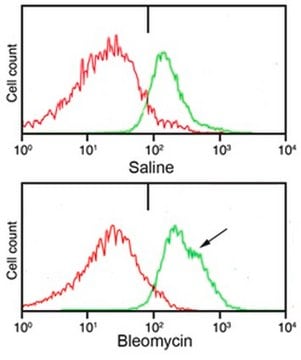MAB1912
Anti-Procollagen Type I Antibody, NT, clone M-58
culture supernatant, clone M-58, Chemicon®
Synonym(s):
Anti-Procollagen Antibody, Clone M-58 Anti-Procollagen, Type I Procollagen Detection
Sign Into View Organizational & Contract Pricing
All Photos(1)
About This Item
UNSPSC Code:
12352203
eCl@ss:
32160702
NACRES:
NA.41
Recommended Products
biological source
rat
Quality Level
antibody form
culture supernatant
clone
M-58, monoclonal
species reactivity
human
should not react with
rat, hamster, mouse
manufacturer/tradename
Chemicon®
technique(s)
immunohistochemistry: suitable (paraffin)
isotype
IgG2α
NCBI accession no.
UniProt accession no.
target post-translational modification
unmodified
Gene Information
human ... COL1A1(1277)
Specificity
Recognizes Human pro-collagen I. MAB1912 labels the amino-terminal pro-peptide.
Application
Detect Procollagen Type I using this Anti-Procollagen Type I Antibody, N-terminus, clone M-58 validated for use in IH(P).
Immunohistochemistry: 1:10,000-1:50,000 (fresh frozen tissue sections.)
Suitable for formaldehyde/formalin fixed paraffin sections, suggested starting dilution 1:100-1:1000, after treatment with 1% trypsin, 20 minutes at room temperature. Does not stain mature collagen fibers in tissue. Localized intracellularly in cells producing pro-collagen I. Not recommended for Western Blots Optimal working dilutions must be determined by end user.
Suitable for formaldehyde/formalin fixed paraffin sections, suggested starting dilution 1:100-1:1000, after treatment with 1% trypsin, 20 minutes at room temperature. Does not stain mature collagen fibers in tissue. Localized intracellularly in cells producing pro-collagen I. Not recommended for Western Blots Optimal working dilutions must be determined by end user.
Analysis Note
Control
Skin tissue
Skin tissue
Other Notes
Concentration: Please refer to the Certificate of Analysis for the lot-specific concentration.
Legal Information
CHEMICON is a registered trademark of Merck KGaA, Darmstadt, Germany
Storage Class Code
10 - Combustible liquids
WGK
WGK 2
Certificates of Analysis (COA)
Search for Certificates of Analysis (COA) by entering the products Lot/Batch Number. Lot and Batch Numbers can be found on a product’s label following the words ‘Lot’ or ‘Batch’.
Already Own This Product?
Find documentation for the products that you have recently purchased in the Document Library.
Kangkang Zhi et al.
Journal of experimental & clinical cancer research : CR, 29, 66-66 (2010-06-10)
The prognosis of gastric cancer patients is difficult to predict because of defects in establishing the surgical-pathological features. Cancer-associated fibroblasts (CAFs) have been found to play prominent role in promoting tumor growth, invasion and metastasis. Thus raises the hypothesis that
Procollagen 1 expression in atypical fibroxanthoma and other tumors.
Jensen, Kristin, et al.
Journal of cutaneous pathology, 31, 57-61 (2004)
Tianyuan He et al.
Age (Dordrecht, Netherlands), 36(3), 9623-9623 (2014-02-20)
Exposure to oxidants results in cellular alterations that are implicated in aging and age-associated diseases. Here, we report that brief, low-level oxidative exposure leads to long-term elevation of cellular reactive oxygen species (ROS) levels and oxidative damage in human skin
John P McCook et al.
Clinical, cosmetic and investigational dermatology, 9, 167-174 (2016-08-16)
To examine the effect of sodium copper chlorophyllin complex on the expression of biomarkers of photoaged dermal extracellular matrix indicative of skin repair. Following a previously published 12-day clinical assessment model, skin biopsy samples from the forearms of four healthy
Are fibrocytes present in pediatric burn wounds?
Andrew J A Holland,Sarah L S Tarran,Heather J Medbury,Ann K Guiffre
Journal of Burn Care & Research : Official Publication of the American Burn Association null
Our team of scientists has experience in all areas of research including Life Science, Material Science, Chemical Synthesis, Chromatography, Analytical and many others.
Contact Technical Service







